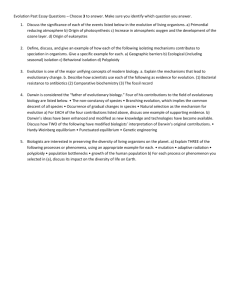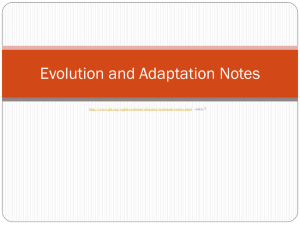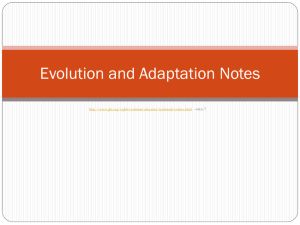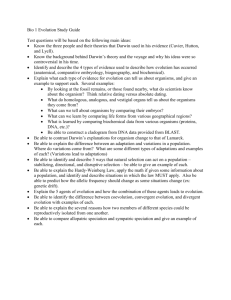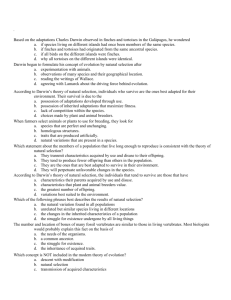Evolution PREAP 2015
advertisement
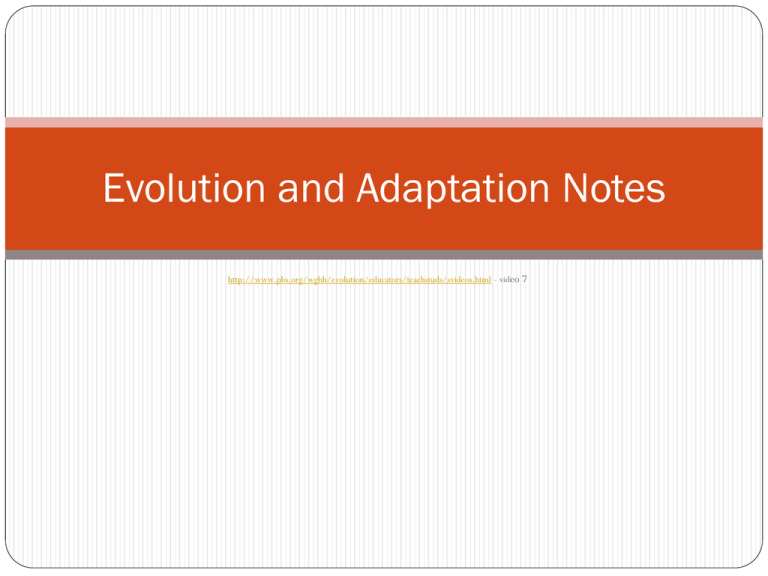
Evolution and Adaptation Notes http://www.pbs.org/wgbh/evolution/educators/teachstuds/svideos.html - video 7 What is Evolution?? Evolution Evolution - Change in a kind of organism over time; process by which modern organisms have descended from ancient organisms. What is a Theory versus a Hypothesis? https://www.youtube.com/watch?v=85diEXbJBIk - video 1 Hypothesis An educated guess that has to be testable by scientific methods Theory Has to be wellsupported and has been tested over and over Is an explanation of a phenomena that has occurred in the natural world. Origins of Evolutionary Thought 1. 1785 - James Hutton: Proposes that earth is shaped by geological forces that took place over extremely long periods of time (gradualism). He estimates Earth to be millions – not thousands – of years old. 2. 1798 – Thomas Malthus: Predicts that the human population will grow faster than the space and food supplies needed to sustain it. Origins of Evolutionary Thought 3. 1809 – Jean-Baptiste Lamarck: Proposed that changes in environment caused an organism to have greater use or disuse of a structure/organ. His ideas are flawed, but he is one of the first to propose a new mechanism explaining how organisms change over time (inheritance of acquired traits). 4. 1833 – Charles Lyell: Observed processes that made small changes in Earth’s features are uniform through time and have shaped Earth’s geological features over long periods of time. Charles Darwin During Darwin’s trip around the world he noticed all the variation (different physical traits of an individual in the group it belongs) of traits among similar species. Charles Darwin - The Galápagos Islands Giant tortoises & Finches varied according to the island each inhabited. These species were able to adapt with adaptations ( a feature that allows an organism to better survive and reproduce in its environment) to their surroundings. Charles Darwin- insight leading to natural selection Darwin noticed lots of variation of species in nature and on farms. Saw breeders were selecting only the largest hogs, the fastest horses, or the cows that produced the most milk and breeding those with each other. Darwin termed this process artificial selection. Artificial selection –When humans select those variations provided by nature that they found useful/beneficial. Charles Darwin- insight leading to natural selection Darwin used all prior scientist knowledge along with his own findings and proposed a mechanism for evolution called natural selection. Darwin’s Conclusions Evolution Occurs by Natural Selection 1. Struggle for survival exists in nature Competition among members of a species exist for food, living space, and the other necessities of life. Survival of the Fittest – Individuals that are better suited to their environment – that it, with adaptations that enable fitness – survive and reproduce more successfully; Darwin referred to this as natural selection 1. Fitness - Ability of an organism to survive and reproduce relative to other members of the population in its environment. http://www.pbs.org/wgbh/evolution/educators/teachstuds/svideos.html - video 4 Darwin’s Conclusions Evolution Occurs by Natural Selection 2. Adaptation Certain variations allow individuals to adapt and survive better in their environment. Those more successful will live longer and share those adaptations to future generations. Natural selection cannot be seen directly; it can only be observed as changes in a population over many successive generations. http://www.pbs.org/wgbh/evolution/educators/teachstuds/svideos.html - video 6 Adaptations Adaptation – Inherited characteristic that increases an organism’s chance of survival. Can be either physical or behavioral. Animals have evolved their adaptations. A long period of slow change resulted in an animal’s adaptations. Example: The spots on the snow leopard did not emerge overnight. Instead, this process took generation upon generation of snow leopards physically adapting to their environment for characteristic spot patterns to evolve. Those leopards with spot patterns were able to hide more successfully, therefore surviving longer than those without spots. This allowed the longer surviving snow leopards to reproduce and create more snow leopards with spot patterns like their own. This process of change over time is the key to how many organisms develop adaptations. Some adaptations can arise quickly through genetic mutations as well. But some mutations can be deadly as well. Darwin’s Conclusions Evolution Occurs by Natural Selection 3. Decent with Modification Darwin proposed that over long periods, natural selection produces organisms have different structures, establish different niches, or occupy different habitats = species today look different from their ancestors. Each living species has descended, with changes, from other species over time. Darwin referred to this principle as descent with modification Darwin’s Conclusions Evolution Occurs by Natural Selection 4. Variation Many genes have at least two genes or alleles. Animals such as dogs, horses, and mice often have several alleles for traits such as body size or coat color. All organisms have additional genetic variation that is “invisible” because it involves small differences in biochemical processes. An organism can be heterozygous for many genes. Evidence of Evolution comes primarily from these sources…. http://www.pbs.org/wgbh/evolution/educators/teachstuds/svideos.html - video 3 1. Fossil record 2. Geographical distribution of living species 3. Structural similarities of related life forms 4. Chemical similarities in DNA 5. Embryology Evidence of Evolution: Fossil Record Fossils are direct or indirect remnants of the past. The fossil record provides evidence about the history of life on Earth. It also shows how different groups of organisms, including species, have changed over time, that life on Earth has changed. The fossil record is not completethere are gaps but they are being filled as we speak!!! 99% of living species are now extinct Fossil record of horses In 1974 remains of this skeleton were found in Ethiopia and lived 3-3.9 million yrs ago. She was 3 ft. 8 in tall and weighed ~65 lbs. Because of her pelvis she was one of the first to show upright walking. She has a really small skull but front teeth like a human. “Lucy’s baby” – in 2006 they found the oldest earliest child fossil in Ethiopia – about 3 yrs old, female, skull, milk teeth, tiny fingers, torso, foot and kneecap (no bigger than a dried pea) – more complete than Lucy and 120,000thousands of years older even. Age of Fossils Paleontologists determine the age of fossils using two techniques: 1. Relative dating 2. Radioactive dating Relative Dating Radioactive Dating Relative Dating In relative dating, the age of a fossil is determined by comparing its placement with that of fossils in other layers of rock. Paleontologists estimate the age based on the age of other fossils found near it. It’s not absolute and doesn’t tell the age in years.. The rock layers form in order by age: • The oldest layers on the bottom • More recent layers on top (closer to Earth's surface) Radioactive Dating Scientists use radioactive decay to assign absolute ages to rocks. Some elements (C, K, Ar) found in rocks are radioactive. Radioactive elements decay, or break down, into nonradioactive elements at a steady rate, which is measured in a unit called a half-life. In radioactive dating, scientists calculate the age of a sample based on the amount of remaining radioactive isotopes it contains. Radioactive Decay A half-life is the length of time required for half of the radioactive atoms in a sample to decay. After 1 half-life - Half of the original radioactive atoms in a sample have decayed. Of those remaining atoms, half again are decayed after another half-life. Evidence of Evolution: Biogeography Similar, but unrelated species exist. Similar animals in different locations were the product of different lines of evolutionary descent. Some animals on each continent live under similar ecological conditions. Are exposed to similar pressures of natural selection. Because of these similar selection pressures, different animals ended up evolving certain striking features in common. Evidence of Evolution: Structural Similarities of Living Things 1. Homologous Structures 2. Analogous Structures 3. Vestigial Structures Homologous Structures of Living Organisms Researchers had noticed striking anatomical similarities among the body parts of animals with backbones. Example: The arms of reptiles, wings of birds, and legs of mammals vary greatly in form and function.Yet, they are all constructed from the same basic bones. Homologous Structures Homologous Structures - Structures that have different mature forms in different organisms but develop from the same embryonic tissues. Same development - different function. Provide strong evidence that all four-limbed vertebrates have descended, with modifications, from common ancestors. Analogous Structures Analogous Structures - Structures that evolve separately to perform a similar function. Different development – same function. Provides evidence for convergent evolution because they have very similar structures even though they were completely independently derived to fill a similar purpose. Examples: Wings of birds, bats, and insects (have different embryological origins but are all designed for flight). Vestigial Organs Vestigial Organs – Organ that serves no useful function in an organism; Traces of homologous structures. Examples: Hip bones found in whales, salamanders, and pythons 2. Eye bulbs of blind, cave-dwelling creatures, such as the grotto salamander. 3. Human coccyx bone (tail bone) – lost original function of a tail but now serves as places for bones to attach 1. Evidence of Evolution: Chemical Similarities All of the tens of thousands of types of proteins in living things are made of only 20 kinds of amino acids. Despite the great diversity of life on our planet, the simple language of the DNA code is the same for all living things. This is evidence of the fundamental molecular unity of life. New technologies, such as DNA fingerprinting, have helped to fill in gaps in the fossil record. Amino Acid Comparison http://www.pbs.org/wgbh/evolution/educators/teachstuds/svideos.html - video 5 The more closely related two species are, the more amino acid sequence similarities should be seen. A B C D E F Try to guess which embryo is the: Chicken? Rabbit? Fish? Human? G H Evidence of Evolution: Similarities in Embryology The early stages, or embryos, of many animals with backbones are very similar. Many embryos look especially similar during early stages of development. The same groups of embryonic cells develop in the same order and in similar patterns to produce the tissues and organs of all vertebrates. EVOLUTION OF POPULATIONS How does a population of penguins evolve?? Variation increases chance of survival Genetic variation is studied in populations. A population is a group of individuals of the same species that interbreed. Because members of a population interbreed, they share a common group of genes called a gene pool. Gene Pool - Consists of all genes, including all the different alleles, that are present in a population. Sources of Genetic Variation The two main sources of genetic variation are: 1. Mutations – Any change in a sequence of DNA. Can occur because of mistakes in the replication of DNA or as a result of radiation or chemicals in the environment. 2. Recombination - The natural formation in offspring of genetic combinations not present in parents. Independent assortment occurs during the production of gametes – each homologous pair moves independently during meiosis. Crossing over during meiosis further increases variation. Natural Selection acts on distribution of traits Natural selection can affect the distributions of phenotypes in any of three ways: 1. Directional Selection 2. Stabilizing Selection 3. Disruptive Selection Directional Selection Directional Selection – Takes place when individuals at one end of the curve have higher fitness than individuals in the middle or at the other end. The range of phenotypes shift as some individuals fail to survive and reproduce while others succeed. Ex – drug resistant bacteria Stabilizing Selection Stabilizing Selection – Takes place when individuals near the center of the curve have higher fitness than individuals at either end of the curve. This situation keeps the center of the curve at its current position, but it narrows the overall graph. Example: The weight of human infants – smaller than average babies are likely to be less healthy and larger than average babies are likely to have difficulty being born. Disruptive Selection Disruptive Selection – Takes place when individuals at the upper and lower ends of the curve have higher fitness than individuals near the middle. In such situations, selection acts most strongly against individuals of an intermediate type. If the pressure of natural selection is strong enough and lasts long enough, this situation can cause the single curve to split into two (can create two distinct phenotypes). Graph Practice Each of your graphs show the number of flies with different phenotypes or wing lengths. They live on an isolated island where competition is fierce. Long wing flies fly 20 m high off ground Short wing flies fly less than 5 m above ground Medium wing flies fly at an average of 12 m off of the ground. DRAW a CURVE on each graph that shows the changes of the environment for each case listed. Other Mechanism for Evolution besides natural selection Gene Flow - The movement of alleles (genes) from one population to another. Affected by: 1. Mobility 2. Barriers 3. Environment (wind) Other Mechanism for Evolution besides natural selection Genetic Drift - Random change in allele frequencies that occurs in small populations due to chance. Unlike natural selection because: 1. 2. It happens by chance – caused by big event like overhunting or a natural disaster (fire, landslide or lightning strike). Doesn’t work to produce adaptations like natural selection does. How Does Genetic Drift Occur? 1. In each generation, some individuals may, just by chance, leave behind a few more descendants (and genes, of course) than other individuals. 2. The genes of the next generation will be the genes of the “lucky” individuals, not necessarily the healthier or “better” individuals. 3. It happens to all populations – there’s no avoiding the vagaries of chance. Evolution vs. Genetic Equilibrium To clarify how evolutionary change operates, scientists often find it helpful to determine what happens when no change takes place. So biologists ask: Are there any conditions under which evolution will not occur? The Hardy-Weinberg Principle Hardy Weinberg Equation: p2 + 2pq + q2 = 1 p+q=1 Hardy-Weinberg Principle Five conditions are required to maintain genetic equilibrium from generation to generation: 1. There must be random mating. o 2. The population must be very large. o 3. Individuals may bring new alleles into a population. There can be no mutations. o 5. Genetic drift has less effect on large populations than on small ones. There can be no movement into or out of the population. o 4. All members of the population must have an equal opportunity to produce offspring, which ensures that each individual has an equal chance of passing on its alleles to offspring. If genes mutate from one form into another, new alleles may be introduced into the population, and allele frequencies will change. There can be no natural selection. o No phenotype can have a selective advantage over another. The Hardy-Weinberg Equation p2 = Frequency of AA 2pq = Frequency of Aa q2 = Frequency of aa p = Frequency of A q = Frequency of a For example: If the frequency of two alleles in a gene pool is 90% A , and 10% a, what is the frequency of individuals in the population with the genotype Aa? Solve: p = frequency of A, which is .9 (90%) q = frequency of a, which is .1 (10%) 2pq = frequency of Aa = 2(.9)(.1) = .18 Therefore, the frequency of individuals with genotype Aa would be .18 The Process of Speciation How do these changes from natural selection or chance lead to the formation of new species, or speciation? Species - Group of organisms that breed with one another and produce fertile offspring Speciation & Reproductive Isolation The gene pools of two populations must become separated for them to become new species. As new species evolve, populations become reproductively isolated from each other. Reproductive Isolation - When the members of two populations cannot interbreed and produce fertile offspring. Reproductive Isolation Reproductive isolation occurs when members of different populations can no longer mate successfully. 1. Behavioral Isolation 2. Geographic Isolation 3. Temporal Isolation Behavioral Isolation Behavioral Isolation - Two populations are capable of interbreeding but have differences in courtship rituals or other reproductive strategies that involve behavior. Example: Eastern and Western Meadowlarks Members of the two species will not mate with each other partly because they use different songs to attract mates. Eastern meadowlarks will not respond to western meadowlark songs, and vice versa. Geographic Isolation With geographic isolation, two populations are separated by geographic barriers such as rivers, mountains, or bodies of water. Example: The Abert & Kaibab Squirrel About 10,000 years ago, the Colorado River split the species into two separate populations. Two separate gene pools formed. Natural selection worked separately on each group and led to the formation of a distinct subspecies, the Kaibab squirrel. Temporal Isolation Temporal Isolation - Form of reproductive isolation in which two populations reproduce at different times. Example: Three similar species of orchid all live in the same rain forest. Each species releases pollen only on a single day. Because the three species release pollen on different days, they cannot pollinate one another. Patterns of Evolution Some large-scale evolutionary patterns and processes that occur over long periods of time are: 1. 2. 3. 4. 5. 6. Extinction Convergent Evolution Divergent Evolution Gradualism Punctuated Equilibrium Coevolution Extinction More than 99% of all species that have ever lived are extinct. Extinctions happen because species compete for resources, and environments change. Some species adapt and change. Others gradually become extinct in ways that are often caused by natural selection. Each disappearance of species left habitats open and provided ecological opportunities for those organisms that survived. The result is often the burst of evolution that produces many new species. The extinction of the dinosaurs cleared the way for the evolution of modern mammals and birds. Convergent Evolution Convergent Evolution – Process by which unrelated organisms come to resemble one another. (analogous structures) Examples: 1. Natural selection may mold different body structures, such as arms and legs, into modified forms, such as wings or flippers. The wings or flippers function in the same way and look very similar. 2. The similar nature of the wings of insects, birds, pterosaurs, and bats. All four serve the same function and are similar in structure, but each evolved independently and not from a common winged ancestor. Divergent Evolution Divergent Evolution – The process of two or more related species becoming more and more dissimilar. (homolougous structures) A single species or a small group of species have evolved, through natural selection and other processes, into diverse forms that live in different ways. The vertebrate limb is one example of divergent evolution. The limb in many different species has a common origin, but has diverged somewhat in overall structure and function Gradualism vs. Punctuated Equilibrium How quickly does evolution occur? Gradualism – Long time with gradual change. Punctuated Equilibrium Long, stable periods interrupted by brief periods of more rapid change. Think about this…How did a tiger get its stripes? Gradually or with a huge, quick change? Coevolution Coevolution – the process in which two or more species evolve in response to changes in each other. Common Misconceptions Humans did not come from monkeys. Instead, humans and primates share a common ancestor. Darwin is not the only evolutionary theorist. Darwin utilized evidence from other evolutionists to draw his conclusions. Evolution does not happen quickly – it occurs over generations of time. Change does not occur at the individual level – it occurs in populations. Cladogram Cladogram – Diagram that shows the evolutionary relationships among a group of organisms. Is constructed using derived characters, which are characteristics that appear in recent parts of a lineage but not in older members. Phylogeny Phylogeny - Study of evolutionary relationships among organisms. Biologists now group organisms into categories that represent lines of evolutionary descent, or phylogeny, not just physical similarities. Now watch the Homer Simpson video again….. http://www.youtube.com/watch?v=faRlFsYmkeY Why is this cartoon inaccurate? Use the information that you’ve learned about evolution in this unit! Adaptions Catepillar that looks like a snake
